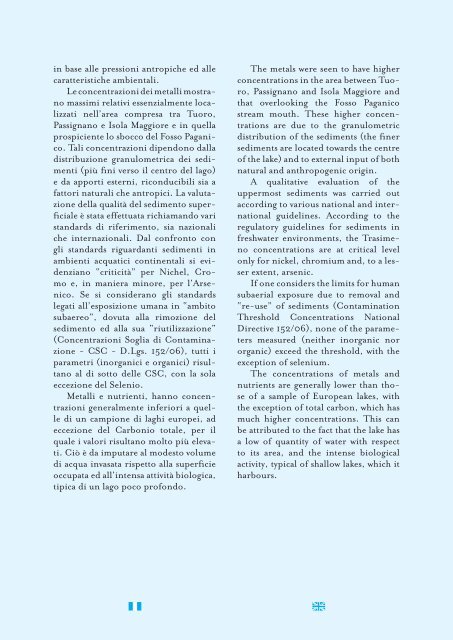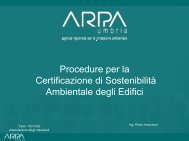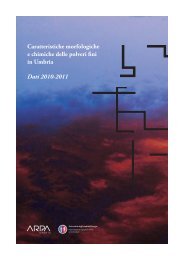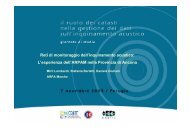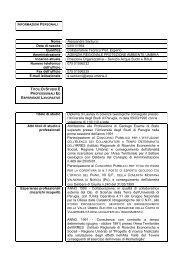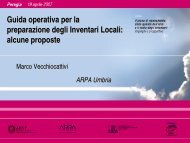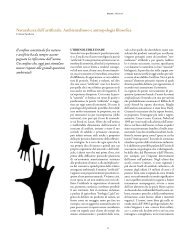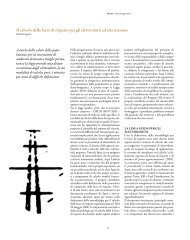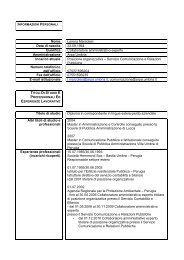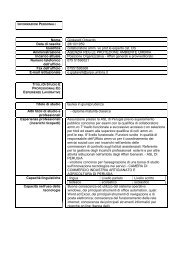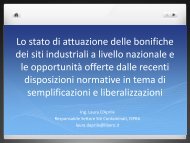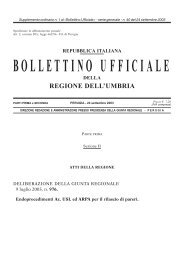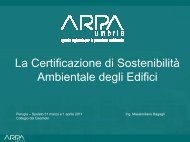Tutela ambientale del Lago Trasimeno - ARPA Umbria
Tutela ambientale del Lago Trasimeno - ARPA Umbria
Tutela ambientale del Lago Trasimeno - ARPA Umbria
Create successful ePaper yourself
Turn your PDF publications into a flip-book with our unique Google optimized e-Paper software.
1 2 2 A r p a U m b r i a 2 0 1 2<br />
in base alle pressioni antropiche ed alle<br />
caratteristiche ambientali.<br />
Le concentrazioni dei metalli mostrano<br />
massimi relativi essenzialmente localizzati<br />
nell’area compresa tra Tuoro,<br />
Passignano e Isola Maggiore e in quella<br />
prospiciente lo sbocco <strong>del</strong> Fosso Paganico.<br />
Tali concentrazioni dipendono dalla<br />
distribuzione granulometrica dei sedimenti<br />
(più fini verso il centro <strong>del</strong> lago)<br />
e da apporti esterni, riconducibili sia a<br />
fattori naturali che antropici. La valutazione<br />
<strong>del</strong>la qualità <strong>del</strong> sedimento superficiale<br />
è stata effettuata richiamando vari<br />
standards di riferimento, sia nazionali<br />
che internazionali. Dal confronto con<br />
gli standards riguardanti sedimenti in<br />
ambienti acquatici continentali si evidenziano<br />
“criticità” per Nichel, Cromo<br />
e, in maniera minore, per l’Arsenico.<br />
Se si considerano gli standards<br />
legati all’esposizione umana in “ambito<br />
subaereo”, dovuta alla rimozione <strong>del</strong><br />
sedimento ed alla sua “riutilizzazione”<br />
(Concentrazioni Soglia di Contaminazione<br />
- CSC - D.Lgs. 152/06), tutti i<br />
parametri (inorganici e organici) risultano<br />
al di sotto <strong>del</strong>le CSC, con la sola<br />
eccezione <strong>del</strong> Selenio.<br />
Metalli e nutrienti, hanno concentrazioni<br />
generalmente inferiori a quelle<br />
di un campione di laghi europei, ad<br />
eccezione <strong>del</strong> Carbonio totale, per il<br />
quale i valori risultano molto più elevati.<br />
Ciò è da imputare al modesto volume<br />
di acqua invasata rispetto alla superficie<br />
occupata ed all’intensa attività biologica,<br />
tipica di un lago poco profondo.<br />
The metals were seen to have higher<br />
concentrations in the area between Tuoro,<br />
Passignano and Isola Maggiore and<br />
that overlooking the Fosso Paganico<br />
stream mouth. These higher concentrations<br />
are due to the granulometric<br />
distribution of the sediments (the finer<br />
sediments are located towards the centre<br />
of the lake) and to external input of both<br />
natural and anthropogenic origin.<br />
A qualitative evaluation of the<br />
uppermost sediments was carried out<br />
according to various national and international<br />
gui<strong>del</strong>ines. According to the<br />
regulatory gui<strong>del</strong>ines for sediments in<br />
freshwater environments, the <strong>Trasimeno</strong><br />
concentrations are at critical level<br />
only for nickel, chromium and, to a lesser<br />
extent, arsenic.<br />
If one considers the limits for human<br />
subaerial exposure due to removal and<br />
“re-use” of sediments (Contamination<br />
Threshold Concentrations National<br />
Directive 152/06), none of the parameters<br />
measured (neither inorganic nor<br />
organic) exceed the threshold, with the<br />
exception of selenium.<br />
The concentrations of metals and<br />
nutrients are generally lower than those<br />
of a sample of European lakes, with<br />
the exception of total carbon, which has<br />
much higher concentrations. This can<br />
be attributed to the fact that the lake has<br />
a low of quantity of water with respect<br />
to its area, and the intense biological<br />
activity, typical of shallow lakes, which it<br />
harbours.


